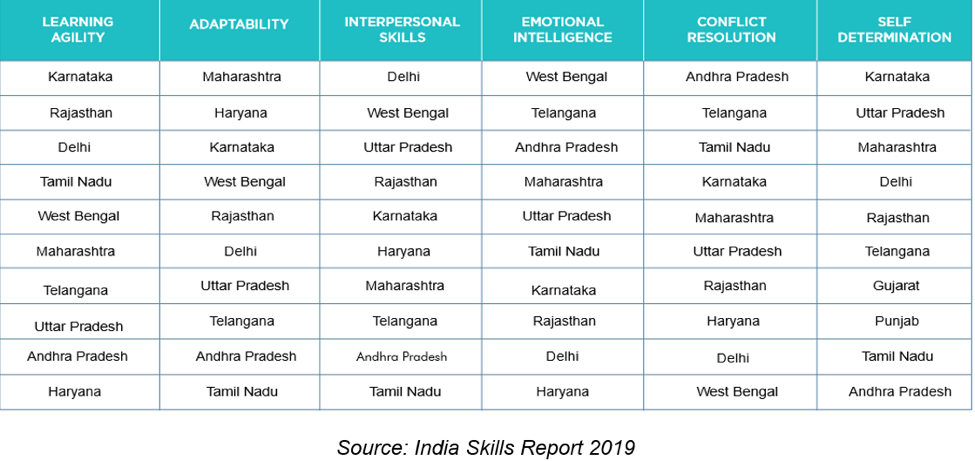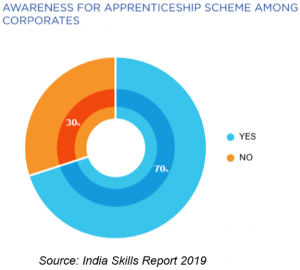The sixth edition of the India Skills Report (2019)[i] provides insight into emerging trends and changes in the Indian jobs and skills marketplace from both demand and supply sides in skill capabilities in the country.
The report states findings from over 3 lakh students across 29 States and 7 Union Territories, and over 1,000 companies across all major sectors. Such reports are useful in sparking debate and action given that by 2020 almost 60% of India’s population of 1.3 billion will be in the working age group of 15-59 years, of which 144 million will be in the 18-23 age bracket.
The 2019 edition captures the following:
- Employability & hiring trends
- Automation & impact on the industry
- New types of jobs
- Candidate & employer job preferences
Salient Findings
Employability continues to show an uptick, with a new high of 47.38% this year, which is an almost 4% increase from 2018. Nirmal Singh, Founder and CEO of Wheebox said, “The increase in employability touching 47% is a good sign for the market. But, we have a long way to go and the entire ecosystem should focus on bridging the employability gaps and enhancing the talent pool, thus taking measures from school level to professional level focusing on learning.”


Engineers continue to rule the roost as the most employable among all professions. MBA holders conversely have fallen in employability from 37.39 percent to 36.44 percent in 2018-2019.

Of interest to us from a vocational education perspective, the employability of ITI pass-outs shows a dramatic decrease of 30% between 2017-2018. This is concerning considering that ITIs are a major conduit for technical and vocational skills training in India and central to flagship government skilling initiatives. The reasons for the significant drop in the employability of ITI graduates have not been stated in the report.
Similarly, of equal alarm are employability figures of polytechnic pass-outs for 2019, prior to which there was a steady increase in employability between 2014-18, sharply falling 44% in 2019 compared to 2018. Again, the reasons are unknown.
These figures indicating a chasm between skills and job readiness from two major sources of vocational and technical skills training in the country should be picked up urgently by the government and industry stakeholders to explore the reasons and take necessary action. It will also be a useful exercise to delve into which subjects or areas of training from ITIs and polytechnics have contributed most to the fall in employability, and how many fall under vocational and skills training.
Overall, hiring intent by Indian employers shows a 5% jump in 2019 with hiring in technology companies picking up steam after a lull of 2 years. Other prominent sectors to experience hiring in 2019 are banking, financial services, and insurance, and manufacturing. Job roles which will experience the most hiring are artificial intelligence, design, analytics, R&D.

Nearly 40-50% of existing transaction heavy jobs are estimated to undergo some form of automation with jobs such as data entry clerk, cashier, customer service executive, factory worker, retail sales executive etc. being most affected as their roles get re-defined. Allaying fears of job loss from automation or Industry 4.0 the market, in fact, witnessed a hiring intent of 10% in 2018 compared to 7% in 2017. This trend is forecast to continue with software & IT, financial services, hospitality & travel, engineering, and automotive sectors seeing a surge in hiring numbers.


Also read
- Getting an Apprenticeship Program Off the Ground- A Toolkit for Employers and
- What’s in it for businesses to engage with apprenticeships?
On the flip side, however, 63% of employers across all sectors felt that only ‘some job seekers’ or ‘no job seekers’ meet the required skills. 84% of students surveyed cited interest in exploring internship opportunities however only 37% of employers offer internships to freshers.
This feels like a big missed opportunity as this report found that employers across major sectors preferred to hire someone with work experience. Internships and/or apprenticeships seem to be a viable springboard to gain that experience.


The Case of Andhra Pradesh
The report shines the spotlight on Andhra Pradesh (AP) for all the right reasons.
- The most preferred location for youth looking for work among top 10 states
- The most preferred hiring destination
- State highest in employability
How did Andhra Pradesh (AP) achieve these commendable positions?
The government of AP created a skilling roadmap for the future when it realised the state needed 10 million skilled workers between 2012-2022. Such foresight has helped AP take various initiatives to aid job creation and employability. This brings the focus on the Andhra Pradesh State Skill Development Corporation (APSSDC).
The APSSDC, which is the largest PPP of its kind in the country, was established by Chief Minister Chandrababu Naidu whose vision is to, ‘Make AP the knowledge and skills hub of the country by facilitating the development of a robust skilling ecosystem with international standards. We are on a mission mode to enhance the employability skills of our students and unemployed youth to meet the skilled manpower demand from Industry, spurred by sustained double-digit growth rates in AP.’
To enhance employability, the AP government’s key mandates are training in domain-specific industry recognised courses, ‘Modular Market’ demand courses and soft skills training. This is well in line with the findings of this report that the top 10 Indian states with the highest employability registered not only high domain expertise but also high non-technical skills. Furthermore, when the survey asked employers to cite three highly desirable soft skills apart from technical knowledge, employers ranked communication skills in the first spot, followed by adaptability and learning agility to meet the challenges brought about by disruptive technologies and changing job environments.

Activities run by the APSSDC:
- English proficiency, soft skills and IT training in Social Welfare Residential Schools and Tribal Welfare Residential Schools
- IT courses in 391 Employability Skills Center at degree colleges
- Certification courses in finance and accounting in partnership with major companies such as ZOHO, Tally etc.
Apart from these, the APSSDC has set up six Centres of Excellence with Siemens and 34 technical skill development institutes in 40 engineering and polytechnic schools across the state to train 1 lakh students annually. The aim is to impart industry relevant on-campus training through state-of-the-art machines to make youth job ready. Strong industry links is a core element of these initiatives. We have similarly found that a public-private partnership framework with strong enterprise participation lies at the foundation of mature apprenticeship and training ecosystems. The APSSDC model falls right into that narrative. Such a model greatly augments demand-based skills training leading to higher job creation and greater skills-employer match.
The APSSDC is also creating important linkages with schools, ITIs and polytechnics to expose non-academic students and drop-outs to skilling as a viable option to employment. Again, we have similarly identified the significance of integrating TVET into mainstream education. This is especially vital in the Indian context where dropout rate from formal education peaks at the secondary level.[ii]
Moreover, the AP government has forged partnerships with industry and Sector Skill Councils to skill unemployed youth through programmes such as The Pradhan Mantri Kaushal Vikas Yojana. Local market demand in 20 key sectors (construction, fisheries, food processing, logistics, banking & finance, retail, tourism, oil & gas, beauty & wellness etc) have been identified.
The state has also emerged the winner in the Best Performing State category for two consecutive years in the Ministry of Rural Development’s Deen Dayal Upadhyaya Grameen Kaushalya Yojana scheme which is uniquely focused on rural youth from poor families, under the Skill India campaign.
Case for Apprenticeships
Another skilling route chosen by the Andhra Pradesh government for the unemployed is apprenticeships. Earlier this year the APSSDC organised a first-of-its-kind conference[iii] by any state to promote apprenticeships. APSSDC is actively involved in integrating short-term skill development courses with apprenticeships. Towards this, an Apprenticeship Cell has been created to forge closer ties with industry for provision of apprenticeships.
Speaking at the conference, Mr. Sandeep Kosaraju, General Manager – Operations, APSSDC, said “Apprenticeships are a sustainable solution to the challenge of youth unemployment, preparing the workforce for the dynamic demands of the industry and increasing competitiveness of the job market. We are working towards promoting apprenticeship by linking it with the skilling ecosystem.’
The India Skills 2019 report has similarly picked up on the significance of apprenticeships as a critical element of the country’s training landscape. 70% of employers surveyed stated that they were aware of the Apprenticeship Act.


Ergo, there lies a clear mismatch between awareness of apprenticeships among Indian youth and employers. Interestingly, a high rate of awareness among employers has not necessarily translated into businesses offering apprenticeship places. Only 57% of employers who said they were aware of the Apprenticeship Act had actually registered under the National Apprenticeship Promotion Scheme (NAPS).
Another interesting revelation was that of the 43% of employers who had not registered under the NAPS, 38% of them hire apprentices in their workplaces. This may indicate quite a wide prevalence of informal apprenticeships being executed by enterprises. The reasons for this were not stated by the India Skills 2019 report. However, one may assume that a general awareness of the Apprenticeship Act is not adequate for an employer to start an apprenticeship programme under the NAPS.
References
[i] India Skills Report 2019- All India Council for Technical Education (AICTE), Association of Indian Universities (AIU) along with Wheebox, PeopleStrong and Confederation of Indian Industry (CII).
[ii] Educational Statistics At a Glance, 2018, Department of School Education & Literacy, MoHRD.
[iii] Conference on Implementation of Apprenticeship Scheme in Andhra Pradesh, Jul 7 2018, National Skills Network
[iv] Young India and Work- A Survey of Youth Aspirations, Oct 2018, Observer Research Foundation, World Economic Forum













